Partridgeberry Vine
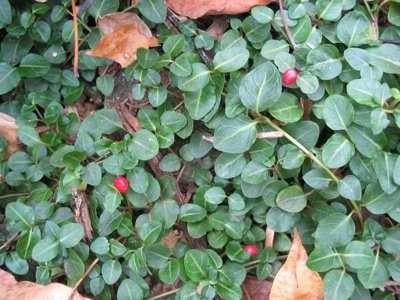
I haunt the pages of Amazon.com; looking for things to share here on TinyGreenGardens.com and things to add to my own gardening and crafting endeavors. The first time I saw this sweet partridgeberry vine being sold as a fairy garden plant, it immediately went on my wish list. I couldn’t wait to buy partridgeberry and add it to my terrarium.
Last week, I finally took the plunge and placed my order. It arrived 5 days later.
What is Partridgeberry?
Partridgeberry is an evergreen herb with the scientific name Mitchella Repens. It also has a long list of other nicknames including Squaw Vine (for its historical use by Native American women), twin berry, one-berry and two-eyed berry.
It is a plant that grows naturally pretty much everywhere east of the Mississippi from Canada to the Gulf of Mexico. I wish we had some growing in our woods. It is a great food source for birds and small animals during the winter months. The flowers also seem attractive to bumblebees. It the partridgeberry vines that I have bought do well, I might donate some to our backyard residents. But, I might keep it in a planter on the back deck as deer have been known to eat partridgeberry berries. Neighbors report seeing deer this year and it would be a shame to let them destroy something that could feed so many of our other backyard visitors – it is said to be a favorite of numerous birds and chipmunks.
Partridgeberry as a Terrarium Plant
Partridgeberry has long been considered a great terrarium plant. In fact, it was suggested in a 1912 edition of American Homes and Gardens (a magazine that was published from 1905-1997 and was reborn as a digital magazine in 2010) that partridge berry should be grown “under a bell glass or in a vivarium – an aquarium-like case for tender house-plants.” While I disagree with their definition of vivarium, I do hope they have it right about growing this diminutive vine under glass.
Partridgeberry vines generally grow up to 8-12 inches long. It is said to not be a climber and it roots along the stem. The leaves range from 1/4 to 1 inch long on a short stalk. The leaves grow in pairs along the vine.
My research said that partridgeberry prefers only minimal sun. After all, in the wild, it grows on the forest floor where it usually gets only limited sun through the tree canopy. It prefers a moist, but not wet, environment. It often grows in the same areas preferred by moss and ferns. Sounds like the perfect terrarium plant to me!
Partridgeberry makes a great terrarium plant as it is considered slow growing. Unfortunately, that has led to this once extremely popular plant becoming a threatened species in Iowa. Apparently, in the early 1900s, partridgeberry was very popular. It was included in many nursery catalogs. The vines and berries were often used for Christmas decorating. My partridgeberry vines came from Pennsylvania and the seller reports that she only sustainably harvests the moss and woodland plants she sells.
Flowering Terrarium Plant
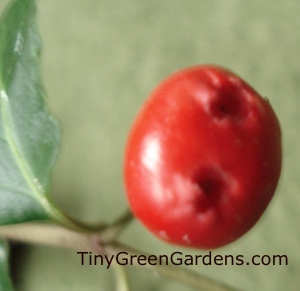 A big part of the reason I wanted to buy partridgeberry is that it is almost always in bloom. From spring to fall, it has pretty four-petaled flowers. The buds are pink and the flowers are white. The flowers grow in pairs and work together to produce the berries. Both flowers in each pair must be pollinated for the berry to form. The berries display their joint parentage with a pair of dimples which are said to represent each of the unique characteristics of the flowers it was formed from.
A big part of the reason I wanted to buy partridgeberry is that it is almost always in bloom. From spring to fall, it has pretty four-petaled flowers. The buds are pink and the flowers are white. The flowers grow in pairs and work together to produce the berries. Both flowers in each pair must be pollinated for the berry to form. The berries display their joint parentage with a pair of dimples which are said to represent each of the unique characteristics of the flowers it was formed from.
As a terrarium plant, I am assuming when mine blooms that I will have to hand-pollinate the flowers if I want berries.
Berries & Propagation
The bright red partridgeberry berries last throughout the cold season. Each berry contains 8 seeds. I’ve read where it is tricky to propagate via seeds. They need to be cold stratified between 3 and 4 months and might not germinate until the second growing season. One source mentioned that putting the seeds in the refrigerator should work but they did not report if they had succeeded in getting them to grow. One vintage source mentioned bringing seedling vines indoors during their first winter.
Another slight gotcha to planting partridgeberry seeds is that the fruit actually inhibits germination and has to be removed for new plants to grow. One source mentioned removing the fruit after cold stratification. But, I can’t help but wonder if the “natural way” for seed dissemination is through birds and other woodland creatures that the fruit might be better removed before stratification.
Most folks propagate partridgeberry by taking cuttings. From what I’ve read, cuttings can be taken any time but one resource did suggest springtime might be preferred. I’m guessing but I suspect that optimal time would be prior to the plant flowering.
What Did Eileen Send Me?
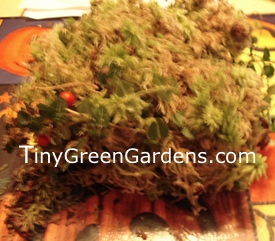 I knew based on the other reviews that the partridgeberry vine would most likely come shipped in a zip lock bag protected by sphagnum moss. First let me say that I’ve never seen live sphagnum moss. I’ve only seen that brown dried up looking stuff sold in nurseries as a soil amendment or to grow orchids in. It is beautiful stuff and I hope I can keep it alive too.
I knew based on the other reviews that the partridgeberry vine would most likely come shipped in a zip lock bag protected by sphagnum moss. First let me say that I’ve never seen live sphagnum moss. I’ve only seen that brown dried up looking stuff sold in nurseries as a soil amendment or to grow orchids in. It is beautiful stuff and I hope I can keep it alive too.
The vines were wrapped in the moss and it was a bit of a tangled puzzle to get the vines separated. Someone on Amazon actually claimed they threw it out because is was such a tangle. I think it’s a brilliant way to keep something moist, healthy and protected during shipment. The untangling was fun, like unwrapping a fragile Christmas present. It took less than 5 minutes. Not sure why the other reviewer found that so very objectionable.
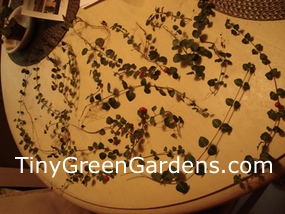 I don’t know how many vines I actually received, the description said “not less than 12”, I got a table full. Just look at all of those lovely vines spread out on our kitchen table. I know the picture is awful but it shows how many rooted pieces of vine I received. Only one piece didn’t have roots and I’m guessing since it had a berry on it that it broke off somewhere between Pennsylvania and North Carolina. It’s now sitting in a tiny glass of water and according to the written instructions I received, it should easily root in the water.
I don’t know how many vines I actually received, the description said “not less than 12”, I got a table full. Just look at all of those lovely vines spread out on our kitchen table. I know the picture is awful but it shows how many rooted pieces of vine I received. Only one piece didn’t have roots and I’m guessing since it had a berry on it that it broke off somewhere between Pennsylvania and North Carolina. It’s now sitting in a tiny glass of water and according to the written instructions I received, it should easily root in the water.
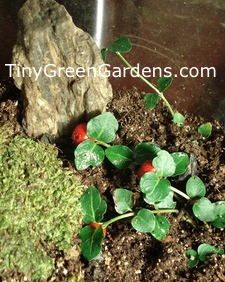 In fact, I received so many pieces of partridgeberry vine in my order that I purchased a small, 5.5 gallon fish tank to plant some of them in. The rest will be going out to the garden.
In fact, I received so many pieces of partridgeberry vine in my order that I purchased a small, 5.5 gallon fish tank to plant some of them in. The rest will be going out to the garden.
Hopefully, in a few years, it will be a wonderful source of winter food for our backyard visitors.
BTW, from now until early November, those plain, old fashioned rectangular, glass fish tanks are on sale at PETCO. Some of them are only $1 a gallon; meaning a 10 or 20 gallon tank would only be $10 or $20. Mine was $15. Of course, don’t bang the corner of yours with a can of soup like I did, otherwise yours will be chipped too. Wanted to cry but so happy it didn’t crack the main glass.
I’ve already put some of my favorite new vine in my cookie jar terrarium. The moss experiment in that container had mixed results. I suspect the biggest problem was a lack of light. I’ve now got it on my desk next to my desk lamp. Hopefully it will perk up and do as well as the glass jar moss garden has been doing.
2024 Update: Unfortunately, the seller has since gone out of business. I’ll leave the information here for reference but, you’re on your own for finding a source for this pretty little vine.
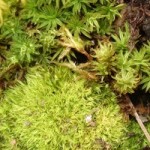
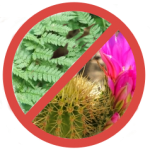
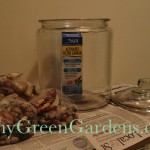
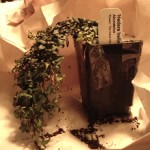
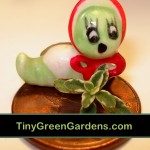

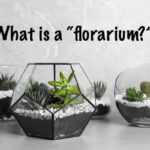

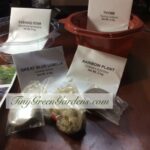
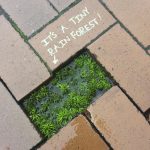
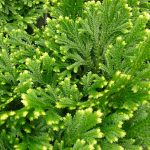

I am enjoying your site..I am 76 (male). My wife acquired a beautiful glass vase 12″ dis.x18″ tall. Not knowing what to do with this, I suggested that it would be perfect for a terrarium. I find your site very informative. I also have a few questions. In Oregon on the East side of the Cascades there exist what I call belly flowers. You have to lay down on your belly to see them. They are from 1/2 to 1 ” tall and have tiny little flowers of many different colors. My question is, about transplanting wild plants, and how to have the best success doing it. Should use some of the soil from the site? 2nd question….How would one go about fumigating plants before inviting unwanted guests such as spider mites and such into your domain? Do you have a list of instructions to get started on building a terrarium garden? Thank you so much for any info in advance. Ron Niederbrach
Hi Ron,
Belly flowers. Love that name. We have a few varieties of those here in Western North Carolina too.
I’m by no means an expert, just a part-time gardener who learns as she goes along. Based on my own experiments and research…
I would be remiss in not mentioning three things… always get permission if you are harvesting on land you don’t own (or at least be smart enough to not get caught 😉 ), if it is a rare native species – leave it alone at least until you get more experience and have a better chance of success (or better yet, just enjoy it in the wild), harvest from larger patches and try to disturb/take as little as possible so the colony continues to grow.
I do have instructions here on Tiny Green Gardens on getting started building a terrarium. Check out the building terrariums section of this site.
As to what I do when harvesting . . . sounds like a great idea for a post. Stay tuned and I’ll put that up sometime soon.